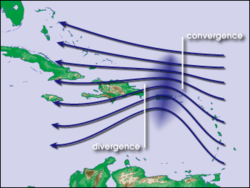Tropical cyclogenesis
Tropical cyclogenesis is a meteorological word used to describe tropical cyclone formation, and its strengthening over the atmosphere.[1] Tropical cyclogenesis happens when the development of a warm-core cyclone, is associated with a lot of convection in a favorable atmospheric environment. Usually, about 86 tropical cyclones of tropical storm strength form worldwide every year, with 47 reaching hurricane/typhoon strength, and 20 becoming strong tropical cyclones (at least Category 3 intensity on the Saffir-Simpson Hurricane Scale).[2]
Tropical Cyclogenesis Media
Schematic representation of flow around a low-pressure area (in this case, Hurricane Isabel) in the Northern hemisphere. The pressure gradient force is represented by blue arrows, the Coriolis acceleration (always perpendicular to the velocity) by red arrows
Tropical Storm Paulette in 2020, with its low-level centre partially exposed due to strong windshear.
Hurricane Pablo formed in the extreme northeastern Atlantic during the 2019 season.
Loop of sea surface temperature (SST) anomalies in the Tropical Pacific
Related pages
References
- ↑ Arctic Climatology and Meteorology. "Definition for Cyclogenesis". National Snow and Ice Data Center. Archived from the original on 2006-08-30. Retrieved 2006-10-20.
- ↑ Chris Landsea. "Climate Variability table - Tropical Cyclones". Atlantic Oceanographic and Meteorological Laboratory, National Oceanic and Atmospheric Administration. Retrieved 2006-10-19.
Other websites
- Current AO conditions
- Current ENSO conditions
- Current MJO conditions
- Current NAO conditions
- Current PNA conditions
- Maximum Potential Intensity
- Maximum Potential Intensity Maps Worldwide Archived 2009-07-05 at the Wayback Machine
- Tropical Cyclone Heat Potential








